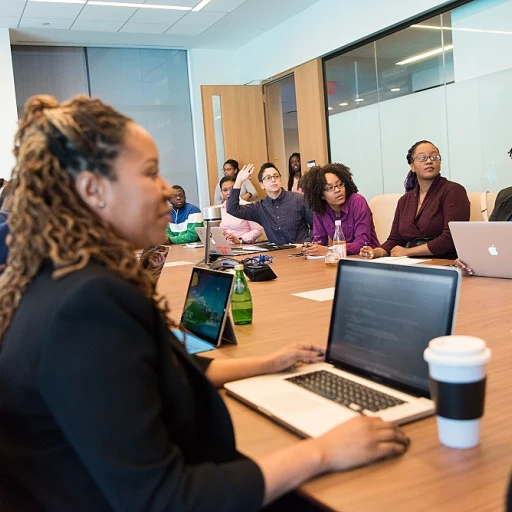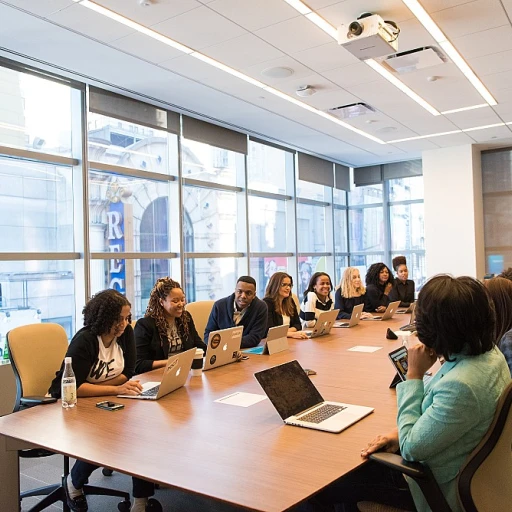Understanding Organizational Culture Inventory
Defining the Organizational Culture Inventory (OCI)
In today's rapidly changing business environment, organizations are continuously seeking ways to enhance their performance and align their operations with their core values and larger purpose. A pivotal component in this journey is understanding the organization's culture - the set of shared beliefs, values, and behaviors that shape how members of an organization interact and work together. One tool that has gained prominence in assessing this culture is the Organizational Culture Inventory (OCI). The OCI serves as a comprehensive culture assessment tool, developed to measure the behavioral norms and expectations within an organization. It provides insights into how organizational culture influences employee engagement, team dynamics, and overall company performance. The survey typically evaluates various "culture styles" manifested within the organization, segmented across competing values that organizations strive for. These can include humanistic, encouraging, or achievement-oriented dimensions, among others. By pinpointing culture styles, companies are able to contrast their current culture with the ideal or preferred culture, taking a strategic step towards effective change management.The Mechanisms Behind Inventory OCI
Organizations using the OCI undertake a culture survey that assesses members' perceptions of current culture norms. This data helps leaders identify gaps between the current and desired culture. With this inventory, leaders can gauge whether their culture aligns with their strategic goals and values—an essential step for driving long-term business success. The value of implementing a robust OCI cannot be overstated. By gaining an accurate picture of their organizational culture, leaders can make informed decisions on culture change initiatives, aligning more closely with the company's mission. Through the identification of cultural misalignments, companies can initiate the necessary adjustments and foster a more engaged, cohesive workplace. For the Chief Human Resources Officer (CHRO), the application of the OCI is critical. It provides a roadmap for shaping an organization culture that resonates with both leaders and employees alike, further enhancing organizational performance. The role of CHROs extends beyond HR management, positioning them as pivotal culture champions within the organization. Learn more about the evolving role of CHROs.The CHRO's Role in Shaping Culture
CHRO's Influence on Cultivating Culture
The Chief Human Resources Officer (CHRO) holds a pivotal position when it comes to shaping the organizational culture. As a top-level executive, the CHRO leads the charge in aligning the organization's culture with its business objectives and values. This alignment is crucial for enhancing team performance and driving positive change throughout the company.
In many ways, the CHRO acts as a steward of the organizational culture. By leveraging tools like the Organizational Culture Inventory (OCI), the CHRO can evaluate both the current culture and the ideal culture of an organization. The insights gathered through such an inventory are invaluable for crafting strategies that promote the desired corporate culture.
To effectively shape the company culture, the CHRO must work collaboratively with other leaders within the organization. This involves engaging with employees to understand their perspectives on the current culture and their aspirations for a preferred culture. By fostering this engagement, CHROs can align the organization's values with the work environment, impacting overall employee engagement and satisfaction.
The influence of a CHRO extends to the integration of a culture change strategy that resonates with the company's mission and vision. It is through this strategic alliance that CHROs oversee initiatives that enhance the organisational culture in a way that supports long-term growth and stability. For more insights on how CHROs can serve as strategic partners in business, you can explore this strategic alliance perspective.
Moreover, the CHRO is responsible for ensuring that the culture is not only comprehensively assessed but also consistently nurtured and evolved. This ongoing commitment helps in maintaining a high-performing, inclusive culture that aligns with the organization's purpose.
Implementing Culture Inventories: Challenges and Strategies
Overcoming Challenges in Implementing Culture Inventories
Implementing a culture inventory, such as the Organizational Culture Inventory (OCI), in any organization can be a daunting task. The transition requires meticulous planning and an understanding of the current organizational culture and its dynamics. Here are key challenges often encountered, along with strategies to address them effectively:
- Resistance to Change: Employees and leaders may resist alterations to the status quo, fearing the unknown impacts of cultural assessments. It's crucial to communicate clearly how these changes align with the organization's purpose and long-term objectives. Engaging stakeholders early in the process helps build trust and reduce apprehension.
- Aligning with Organizational Values: Ensuring that the inventory process aligns with the core values of the organization is essential. This can be achieved by tailoring the survey to reflect these values and ensuring that the desired changes resonate with the business's strategic goals.
- Data Overload: Culture assessments like the OCI generate large volumes of data. It can be overwhelming to interpret results without a clear framework. Prioritize data points that directly connect to organizational performance and employee engagement, enabling targeted initiatives for improvement.
- Maintaining Confidentiality: Employees’ willingness to participate honestly might be hindered by fears about confidentiality. Assuring participants that their responses are anonymized and will be used constructively is vital for obtaining genuine feedback.
- Balancing Cultural Differences: Global organizations may face additional challenges due to varying regional cultural norms. Customizing the culture inventory while maintaining consistent goals helps in achieving a more inclusive assessment.
Effective implementation requires strategic leadership to foster an environment conducive to change. This involves creating cultural champions within the organization who can advocate for and guide their peers throughout the process. For further insights into enhancing leadership roles, you may explore more here.
Analyzing Inventory Results for Organizational Growth
Interpreting Inventory Data for Progress
The analysis of organizational culture inventory (OCI) outcomes involves a meticulous examination of both existing and aspirational cultural dimensions within an organization. For leaders, especially those in human resources, it is crucial to bridge the gap between the current culture and the ideal culture. This process requires a strategic approach to interpreting and leveraging OCI data effectively. To start, it's essential to recognize the prevalent cultural attributes of your business. Existing cultural characteristics can significantly influence employee engagement, performance, and overall organizational success. HR leaders must spotlight this information to identify which cultural traits align with or diverge from the company’s objectives. Utilizing Inventory Insights By translating OCI results into actionable insights, organizations can further define their organizational culture trajectory. The following points can serve as pivotal steps:- Identify Key Cultural Metrics: Pinpoint which culture attributes are beneficial and should be cultivated further, and which may be impediments to growth.
- Engage Leadership and Employees: Collaborate with leaders and employees to discuss findings, building a shared understanding of what the current culture entails and where the improvements are necessary.
- Set Clear, Achievable Goals: Establish clear objectives for cultural enhancement, ensuring they resonate with all organizational members. Leaders should aim to morph current culture characteristics into those that will foster long-term success.
- Measure Progress Regularly: Continuous assessment is crucial to ensure transformation is on track. Employ culture surveys to evaluate shifts in preferred culture over time.
Case Studies: Successful Culture Transformations
Transformative Journeys of OCI Implementation
When organizations embark on the journey of cultural transformation, the successful implementation of Organizational Culture Inventories (OCUS) becomes pivotal. Leveraging this powerful tool, businesses can shape a transformative path that aligns their current culture with their ideal culture, ultimately enhancing employee engagement and performance across all levels. One compelling case is a midsize tech company that faced challenges with employee retention and low morale. By conducting a comprehensive culture survey using the OCI model, the company identified key areas where competing values were stifling innovation and collaboration among team members. The leadership team, invigorated with human synergistics practices, implemented targeted strategies aimed at harmonizing their team dynamics. Through consistent engagement with employees, leaders were able to foster a more inclusive and open organizational culture, bridging the gap between current culture traits and their aspirational goals. As a result, the company witnessed increased employee engagement and a significant boost in overall performance. Another notable example can be seen within an international hospitality organization. Initially grappling with fragmented organizational values, the leadership group employed OCI to gather insights into the prevailing cultural climate and pinpoint elements of shared success. With this data-driven approach, they redesigned their implementation strategies to reinforce a unified corporate culture. As a result, the effort to align organizational values with employee values allowed the organization to grow its customer satisfaction rates while simultaneously fostering a preferred culture that nurtures both personal and professional growth. These case studies exemplify how the strategic application of OCI can lead to long-term sustainable change. When organizations embrace this culture inventory, they not only cement their organization culture but also pave the way for a brighter future for their people and business.Future Trends in Organizational Culture Assessment
Emerging Trends in Culture Assessment
As the global landscape continues to evolve, so too does the need for robust organizational culture assessment mechanisms. The role of human resources leaders, particularly the Chief Human Resources Officer (CHRO), is pivotal in adapting to these changes. Emerging trends in culture assessment reveal a shift towards more dynamic, data-driven approaches. This evolution is crucial in fostering an ideal culture that aligns with the company's purpose and enhances long-term business performance.
One key trend is the increasing use of digital tools and analytics in culture assessments. These tools provide a more comprehensive view of the current culture by analyzing the data collected from various sources within an organization. This allows company leaders to identify patterns and areas for improvement more effectively. This trend supports the transition from traditional methods to more agile and iterative approaches, which are better suited to the fast-paced nature of modern business environments.
Furthermore, there is a growing focus on employee engagement and its impact on organizational culture. Companies are increasingly acknowledging the importance of aligning employee values with organizational goals to achieve optimal performance. This alignment can be achieved through regular culture surveys and the use of inventories such as the Organizational Culture Inventory (OCI). These tools help organizations understand the preferred culture of their employees, enabling leaders to implement targeted culture change initiatives.
Additionally, the role of feedback is becoming more prominent in culture assessments. Regular and open communication between team members and leadership fosters a culture of transparency and trust. This approach not only improves employee engagement but also provides valuable insights into the effectiveness of current culture initiatives. Organizations are encouraged to build feedback loops that can readily identify discrepancies between the existing culture and the ideal culture.
As organizations continue to navigate the complexities of the modern business landscape, these emerging trends highlight the importance of culture assessments. For CHROs and other HR leaders, staying abreast of these trends is essential for supporting organizational growth and development. By integrating these innovations into their practice, leaders can better guide their organizations towards a more cohesive and effective corporate culture that benefits all members.








